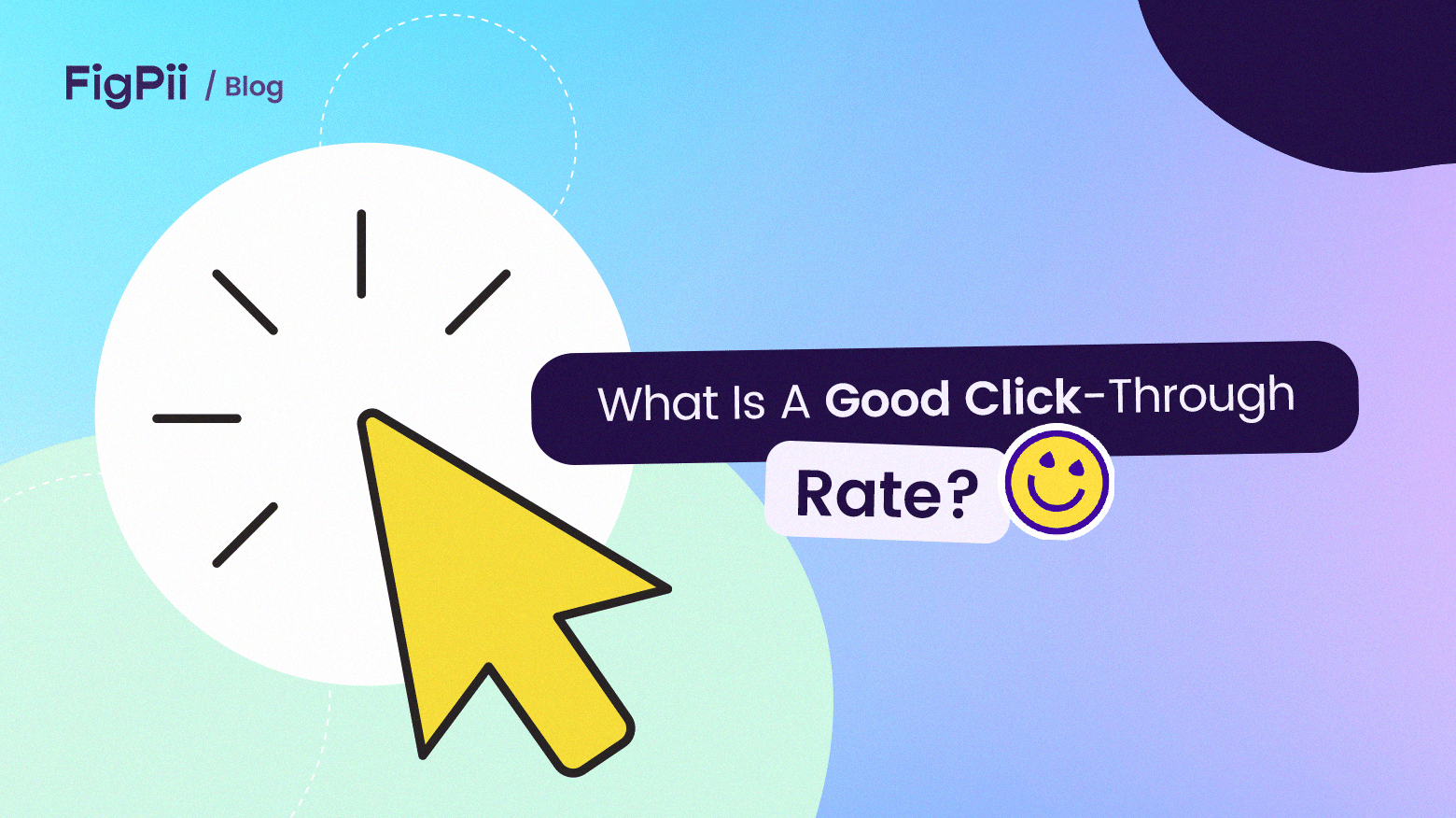Imagine you’re throwing a house party and want it to be the talk of the town. You design great flyers and send out invitations everywhere.
The accurate measure of your party’s success isn’t just how many people see the flyers and how many show up. This concept is similar to Click-Through Rate in digital marketing and advertising.
Just as the number of guests determines your party’s popularity, CTR reveals how effectively your online content attracts and engages your audience.
A high CTR is like a line of guests eagerly waiting to join your party—excited and ready to engage. On the other hand, a low CTR means many people see your flyer, but only a few show up.
This article will explore CTR, why it matters in digital marketing, and what counts as a good CTR across different industries
What is Click-Through Rate?
Click-through rate is a key metric in marketing and advertising that measures the effectiveness of a campaign or ad in generating clicks.
Expressed as a percentage, CTR is the ratio of clicks an element receives (like an ad, link, or button) to the number of times it’s viewed.
In simple terms, CTR tells you what percentage of people clicked on something after seeing it—just like how many people came to your party after seeing your flyer.
CTR is widely used in various digital marketing channels, including search engine marketing (SEM), email marketing, display advertising, social media advertising, and website analytics.
How do you calculate the Click-Through Rate?
To calculate CTR, divide the number of clicks by the number of impressions or views and then multiply by 100 to get the percentage.
For example, if an ad received 500 clicks and 10,000 impressions, the CTR would be (500/10,000) * 100 = 5%.
A high CTR suggests that your content effectively grabs attention and encourages clicks, but it does not necessarily mean the content is engaging.
A catchy headline or attractive offer might result in a high CTR, but engagement can still be low if the content or landing page does not deliver on the promise or meet the audience’s expectations.
This could lead to high bounce rates, low time spent on the page, or minimal conversions.
In short, while a high CTR is a positive indicator of initial interest, it should be paired with other metrics, such as time on page, conversion rate, and user feedback, to assess whether the content is engaging and effective.
What is a good Click-Through Rate?
The definition of a good Click-Through Rate (CTR) can vary depending on the industry, advertising platform, and specific context.
Generally, a higher CTR is considered favorable as it indicates higher user engagement and interest.
In some industries or platforms, an average CTR may range from 1% to 5%.
Anything above the average can be considered good or exceptional, especially if it exceeds industry standards or competitors’ performance.
However, it’s important to note that CTR should not be evaluated in isolation; other metrics, such as conversion rate, return on investment (ROI), and campaign objectives, should also be considered.
It’s important to track and compare CTRs within your specific context and continuously optimize your campaigns to improve performance and achieve your desired outcomes.
Why is Click-Through Rate Important in Digital Marketing and Advertising?
-
Engagement Indicator
CTR is important because it directly shows how well your content or ads capture your audience’s attention. A higher CTR could indicate that your message resonates with viewers, which is essential for building brand awareness and driving user interest.
-
It Can Boost Your Ad Performance
In platforms like Google Ads, CTR is a key factor in determining your Quality Score. A high Quality Score can lead to better ad placements and lower costs per click, making your campaigns more efficient and cost-effective.
-
Drives Traffic to Your Website
A good CTR directly influences the amount of traffic directed to your website. More clicks mean more potential customers are visiting your site, increasing the chances of conversions, whether generating leads or making sales.
-
Performance Optimization
Monitoring and analyzing CTR allows you to fine-tune your digital marketing strategies.
By experimenting with different headlines, images, ad formats, or calls to action, you can identify what resonates most with your audience and optimize your campaigns for better results.
-
Maximizing Your Ad Spend
A well-optimized Click-Through Rate (CTR) can greatly improve your digital marketing campaign’s return on investment (ROI).
Think of it as a win-win situation. When your CTR is on point, you’re not only driving higher engagement and attracting more clicks, but you’re also optimizing your ad spend efficiency.
Industry-specific Benchmarks and Averages For CTR
Industry-specific benchmarks and averages refer to the standard or typical Click-Through Rates (CTR) observed within specific industries.
These benchmarks provide a point of reference for marketers to gauge the performance of their campaigns and compare them against industry norms.
They also help you set realistic goals, identify areas for improvement, and make informed decisions regarding your marketing strategies.
Now, let’s look at the average CTRs for some specific industries. Please note that these numbers can vary based on various factors, and they are intended to provide a general sense of the typical CTR ranges observed:
- E-commerce Industry: The average CTRs for e-commerce range from 0.51% to 2.69%. This industry is highly competitive, and CTRs can vary based on factors such as the product type, target audience, and the effectiveness of marketing tactics.
- Technology Industry: The technology sector often sees CTRs ranging from 0.39% to 2.09%. Given the technical nature of the products and services, crafting targeted and compelling messages to drive engagement is essential.
- B2B (Business-to-Business) Industry: CTRs in the B2B sector typically range from 0.46% to 2.41%. These industries often have niche audiences, and the success of campaigns depends on delivering relevant and valuable content to engage decision-makers and professionals.
- Home Goods Industry: CTRs typically range from 0.5% to 2.44% in the home goods sector. With a focus on lifestyle and aesthetics, capturing the target audience’s attention through visually appealing content can help drive higher CTRs.
- Consumer Services Industry: CTRs in the consumer services sector can vary from 0.51% to 2.41%. This industry includes various services such as travel, entertainment, and food. Creating personalized and enticing offers can help improve CTRs within this sector.
- Financial industry: The financial sector often experiences CTRs ranging from 0.52% to 2.91%. As a highly regulated industry, marketers must build trust, provide valuable information, and ensure compliance to drive engagement.
Factors Affecting Click-Through Rate
These factors work hand in hand. You want your ads to be relevant to your target audience, appear in the right places, have compelling messaging, and feature an irresistible call to action.
-
Ad relevance and Targeting
Picture this—you’re scrolling through your favorite website, and suddenly, you spot an ad that speaks directly to your interests or needs. That’s the power of ad relevance and targeting.
When your ads are tailored to reach the right audience based on demographics, interests, or search intent, you have a higher chance of capturing their attention and enticing them to click.
-
Ad Placement and Visibility
Think of ad placement as the real estate of the digital world. Where you position your ads can significantly impact their visibility and, consequently, their CTR.
Ads that appear above the fold (the portion of the page visible without scrolling) tend to get more attention.
Placing your ads strategically on relevant websites, search engine results pages, or social media platforms can boost visibility and increase the likelihood of clicks.
-
Ad Copy and Messaging
The words you choose and how you craft your ad copy can make or break its effectiveness. Compelling, concise, and attention-grabbing messaging is vital.
You want to communicate the value proposition and benefits of your offering in a way that resonates with your target audience.
Highlighting unique selling points, using persuasive language, and evoking emotions can increase click-through rates.
-
Call-to-action (CTA)
A solid call to action is like a magnetic force that pulls users toward clicking. It’s the moment when you tell them precisely what you want them to do—whether it’s “Shop Now,” “Learn More,” or “Get Your Free Trial.”
A clear, compelling, and action-oriented CTA can create a sense of urgency and guide users to take the desired action.
A/B Test different CTAs to find the ones that resonate best with your audience and lead to higher click-through rates.
How to improve your Ads Click-Through Rate
-
Improve Ad Quality and Relevance
One of the most effective ways to boost your CTR is by improving the quality and relevance of your ads. Start by ensuring your ads align with the intent of your target audience.
Craft compelling and concise ad copy that communicates your unique value proposition. Use relevant keywords, appealing visuals, and captivating headlines to grab attention.
-
Optimize ad Placement and Formats.
The placement and format of your ads can significantly impact their visibility and CTR. Experiment with different ad placements on websites, SERPs, or social media platforms to find the sweet spot for your target audience.
Additionally, explore various ad formats such as text, display, or video to cater to different user preferences and capture attention in different contexts.
-
Experiment with Different Ad Copies and CTAs
Feel free to get creative and experiment with different ad copies and calls-to-action (CTAs). Test different headlines, messaging approaches, and CTA language to find what resonates best with your audience.
A/B testing can be a powerful tool in identifying the most effective ad copies and CTAs, allowing you to optimize and improve your CTR continuously.
-
Utilize Ad Extensions and Additional Features
Ad extensions and additional features from advertising platforms can give your ads an edge. Utilize sitelink extension, callout extension, and structured snippet extensions to provide additional information and increase the visibility of your ads.
These extensions can enhance the relevance of your ads and provide more opportunities for users to engage and click.
Take advantage of any additional features the advertising platform offers to make your ads stand out and drive higher CTR.
-
Continuously Monitor and Optimize Campaigns
Monitoring and optimization are vital for increasing CTR. Regularly analyze campaign performance, keeping an eye on CTR trends and metrics.
Identify underperforming ads or targeting settings and make data-driven adjustments. Use insights from analytics tools to refine your targeting, ad copies, and placements.
Over To You
In the end, CTR is undoubtedly an important metric, but you should also remember that it’s just one piece of the puzzle. There are also other metrics to consider, such as ROI, ROAS, Conversion Rate, etc. These metrics will give a comprehensive understanding of your overall performance.
While optimizing your CTR is valuable, it’s not the sole indicator of success. Don’t fall into the trap of solely focusing on CTR, as a high CTR alone doesn’t guarantee conversions or revenue.
Click-Through Rate FAQs
What does CTR mean?
CTR stands for Click-Through Rate. It measures the percentage of people who click on a link or ad after seeing it. It’s calculated by dividing the number of clicks by the number of impressions and multiplying by 100.
How is CTR calculated?
CTR is calculated by dividing the number of clicks by the number of impressions, then multiplying the result by 100 to get a percentage.
Example: If your ad received 200 clicks and 10,000 impressions, the CTR would be (200 ÷ 10,000) × 100, which equals 2%.
What is a good click-through rate?
A good click-through rate varies by industry, but generally, a CTR between 2% to 5% is considered strong. However, what’s “good” depends on the platform, audience, and type of content.
What is a good CTR for Email?
A good Click-Through Rate (CTR) for email marketing generally falls between 2% to 5%. This can vary based on your industry, audience, and email type. Factors like the quality of your email list and the effectiveness of your content and CTA also influence your CTR.
What is a good CTR in Google Ads?
A good CTR in Google Ads is typically between 4% to 6%. However, what’s considered good can vary by industry. A higher CTR indicates your ad is relevant and engaging, which can improve your Quality Score, leading to better ad placement and lower costs.



